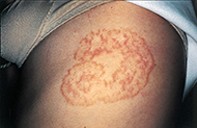Peer Reviewed
Feature Article Infectious diseases
Fungal infections of the skin: a guide for GPs
Abstract
Fungal infections of the skin are a common diagnostic and therapeutic problem seen in general practice. Over-the-counter availability of all antifungal preparations has increased the need for GPs to be aware of partially treated or inappropriately treated fungal infections.
Key Points
- Increased availability of antifungals means that GPs will see more patients partially treated for, or incorrectly diagnosed with, fungal disease.
- Beware of diagnostic pitfalls, including ring-shaped lesions that usually are not fungal and lesions that are altered by treatment.
- Topical therapy often fails because of insufficient treatment time, inadequate area of application, involvement of hair follicles and difficult-to-treat areas, such as the plantar surface of the foot.
- Rural practitioners should be aware of infection with animal- or soil-based fungi that produce a more dramatic inflammatory reaction in humans (kerion).
Purchase the PDF version of this article
Already a subscriber? Login here.

